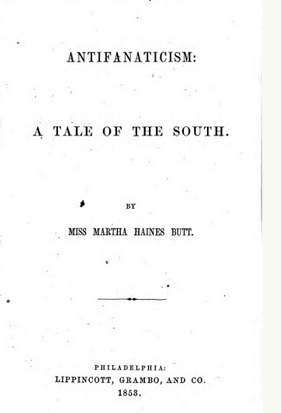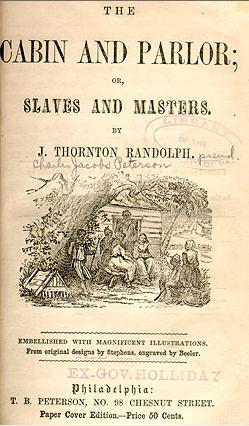
Uncle Tom's Cabin; or, Life Among the Lowly is an anti-slavery novel by American author Harriet Beecher Stowe. Published in two volumes in 1852, the novel had a profound effect on attitudes toward African Americans and slavery in the U.S., and is said to have "helped lay the groundwork for the [American] Civil War".

Harriet Elisabeth Beecher Stowe was an American author and abolitionist. She came from the religious Beecher family and became best known for her novel Uncle Tom's Cabin (1852), which depicts the harsh conditions experienced by enslaved African Americans. The book reached an audience of millions as a novel and play, and became influential in the United States and in Great Britain, energizing anti-slavery forces in the American North, while provoking widespread anger in the South. Stowe wrote 30 books, including novels, three travel memoirs, and collections of articles and letters. She was influential both for her writings as well as for her public stances and debates on social issues of the day.

Dred: A Tale of the Great Dismal Swamp is the second popular novel from American author Harriet Beecher Stowe. It was first published in two volumes by Phillips, Sampson and Company in 1856. Although it enjoyed better initial sales than her previous, and more famous, novel Uncle Tom's Cabin, it was ultimately less popular. Dred was of a more documentary nature whereas Uncle Tom's Cabin had much stronger characters.

A Key to Uncle Tom's Cabin is a book by American author Harriet Beecher Stowe. It was published to document the veracity of the depiction of slavery in Stowe's anti-slavery novel Uncle Tom's Cabin (1852). First published in 1853 by Jewett, Proctor & Worthington, the book also provides insights into Stowe's own views on slavery.

Anti-Tom literature consists of the 19th century pro-slavery novels and other literary works written in response to Harriet Beecher Stowe's Uncle Tom's Cabin. Also called plantation literature, these writings were generally written by authors from the Southern United States. Books in the genre attempted to show that slavery was beneficial to African Americans and that the evils of slavery as depicted in Stowe's book were overblown and incorrect.

Aunt Phillis's Cabin; or, Southern Life as It Is by Mary Henderson Eastman is a plantation fiction novel, and is perhaps the most read anti-Tom novel in American literature. It was published by Lippincott, Grambo & Co. of Philadelphia in 1852 as a response to Harriet Beecher Stowe's Uncle Tom's Cabin, published earlier that year. The novel sold 20,000–30,000 copies, far fewer than Stowe's novel, but still a strong commercial success and bestseller. Based on her growing up in Warrenton, Virginia, of an elite planter family, Eastman portrays plantation owners and slaves as mutually respectful, kind, and happy beings.

The Planter's Northern Bride is an 1854 novel written by Caroline Lee Hentz, in response to the publication of Uncle Tom's Cabin by Harriet Beecher Stowe in 1852.

Tom show is a general term for any play or musical based on the 1852 novel Uncle Tom's Cabin by Harriet Beecher Stowe. The novel attempts to depict the harsh reality of slavery. Due to the weak copyright laws at the time, a number of unauthorized plays based on the novel were staged for decades, many of them mocking the novel's strong characters and social message, and leading to the pejorative term "Uncle Tom".

A number of film adaptations of Harriet Beecher Stowe's 1852 novel Uncle Tom's Cabin have been made over the years. Most of these movies were created during the silent film era. Since the 1930s, Hollywood studios have considered the story too controversial for another adaptation. Characters, themes and plot elements from Uncle Tom's Cabin have also influenced a large number of other movies, including The Birth of a Nation (1915), while also inspiring numerous animated cartoons.
Uncle Robin, in His Cabin in Virginia, and Tom Without One in Boston is an 1853 novel written by J.W. Page and released by J. W. Randolph Publishers of Richmond, Virginia.

Antifanaticism: A Tale of the South is an 1853 plantation fiction novel by Martha Haines Butt.

The Black Gauntlet: A Tale of Plantation Life in South Carolina is an anti-Tom novel written in 1860 by Mary Howard Schoolcraft, published under her married name of Mrs. Henry Rowe Schoolcraft.
Life at the South; or, "Uncle Tom's Cabin" As It Is is an 1852 plantation fiction novel written by William L.G. Smith.

The Cabin and Parlor; or, Slaves and Masters is an 1852 novel by Charles Jacobs Peterson, writing under the pseudonym J. Thornton Randolph.
The Lofty and the Lowly, or Good in All and None All Good is a novel by Maria Jane McIntosh published by D. Appleton & Company in 1853. It was one of many anti-Tom novels published in response to Harriet Beecher Stowe's Uncle Tom's Cabin. The story is set is Georgia and tells of a plantation owner's efforts to avoid bankruptcy with the help of his loyal slave Daddy Cato. Their efforts are challenged by a northern usurer and devious northern capitalists. The book sold well across the United States upon release, making it one of the most successful anti-Tom novels in the middle 19th century.

Mr. Frank, the Underground Mail-Agent is an 1853 parody novel written by an unknown author credited as "Vidi".
The Ebony Idol is a plantation literature novel by G. M. Flanders, first published in 1860. It is one of several pro-slavery novels written in the Southern United States in response to the 1852 abolitionist novel Uncle Tom's Cabin by Harriet Beecher Stowe.

Uncle Tom's Cabin is a 1927 American silent drama film directed by Harry A. Pollard and released by Universal Pictures. The film is based on the 1852 novel Uncle Tom's Cabin by Harriet Beecher Stowe and was the last silent version filmed.

Uncle Tom's Cabin was a 1918 American silent drama film directed by J. Searle Dawley, produced by Famous Players–Lasky Corporation and distributed by Paramount Pictures under the Famous Players–Lasky name. The film is based on Harriet Beecher Stowe's 1852 novel Uncle Tom's Cabin and George Aiken's eponymous play.
Abolitionist children’s literature includes works written for children by authors committed to the movement to end slavery. It aimed to instill in young readers an understanding of slavery, racial hierarchies, sympathy for the enslaved, and a desire for emancipation. A variety of literary forms were used by abolitionist children’s authors including, short stories, poems, songs, nursery rhymes and dialogues, much of it written by white women. Pamphlets, picture books and periodicals were the primary forms of abolitionist children’s literature, often using Biblical themes to reinforce the wickedness of slavery. Abolitionist children's literature was countered with pro-slavery material aimed at children, which attempting to depict slavery as a noble pursuit, and slaves as stupid and grateful, or evil.
















